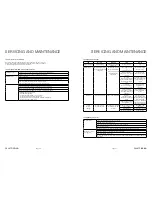
Page 40
Page 41
APPENDIX
APPENDIX A
APPENDIX B
Description
Manual handling means any transporting or supporting of a load (including lifting,
putting down, pushing, pulling, carrying or moving) by hand or bodily force.
Scope
This assessment will cover the largest unit within each product range.
For specific weights and dimensions please refer to technical data section.
Main Hazards
Vision may not be clear due to the size of the products.
Adopting an incorrect method of lifting may cause injury, attempting to lift these
products will require help from others. (Team lifts)
Control Measures
Manual lifting procedure
The lift, key factors in safe lifting are:
a.
Balance
b.
Position of back
c.
Positioning of the arms and body
d.
The hold
e.
Taking the lead for team lifts
a.
Balance - Since balance depends essentially upon the position of the feet,
they should be apart about hip breadth with one foot advanced giving full
balance sideways and forward without tension. In taking up this position,
lifting is done by bending at the knees instead of the hips and the muscles
that are brought into use are those of the thigh and not the back.
b.
Position of back - Straight - not necessary vertical. The spine must be
kept rigid, this coupled with a bent knee position, allows the centre line of
gravity of the body to be over the weight so reducing strain.
c.
Positioning of arms and body - The further arms are away from the side,
the greater the strain on the shoulders, chest and back. Keep elbows close
to the body arms should be straight.
d.
The hold - Before lifting ensure you have a good hold.
e. Taking the lead for team lifts- As
more than one person is required
for these products ensure that one
person is taking the lead. This may
be you so ensure that each person
that is helping is made aware of the
weight and of the items listed within
this assessment. Make sure you and
any others helping know the route
you intend to take that it is clear of
any obstructions. Never jerk the load
as this will add a little extra force and
can cause severe strain to the arms,
back and shoulders. If there are steps
involved decide on where you will
stop and take a rest period. Move
smoothly and in unison taking care
to look and listen to others helping
with the lift. Where possible use
a sack truck to move the product
over long flat distances, only lift the
products when necessary. If in doubt
stop and get more help.
Individual capability
Individual capability plays an important
part in handling these products. Persons
above average build and strength will
find it easier and should be in good
health. Persons below average build and
strength may require more rest periods
during the handling process.
Pregnant women should not carry out
this operation.
Persons who are not in good health
should seek medical advice prior to
commencing any lifting or manual
handling operation.
Residual risk
Following the guidelines given above will
reduce any risk to injury.
All persons carrying out this operation
must be fully trained and copies of the
specific risk assessment made available
for inspection and use in their training
process.
Further guidance on Manual Handling
can be obtained from the Health and
Safety Executive. Manual Handling
Operations Regulations 1992.
MANUAL HANDLING OF APPLIANCE PRODUCTS
APPENDIX
Vast quantities of water are needlessly run off to waste due to Taps, Mixers and Showers
discharging flow rates far in excess of the rates required for them to perform their duties.
The contrasting flow rates shown on this leaflet clearly illustrate the savings that can
be made whilst still providing a good performance.
British made Aquaflow Regulators provide constant flow rates by automatically
compensating for supply pressure changes between 1 bar & 10 bars.
To facilitate installation into the wide range of plumbing equipment which is
encountered in the U.K, Four Fixing Options are available:-
Options For Showers
1. MXF “DW” Range - For fitting behind Fixed Shower Heads or onto Flexible Hoses
for Handshowers (preferably onto the inlet end when lightweight hoses are used).
2. Compression Fitting Range. “In Line” regulators as in Option 4 for Taps & Mixers.
Information by courtesy of
AQUAFLOW REGULATORS LTD
Haywood House, 40 New Road, Stourbridge, West Midlands DY8 1PA
TELEPHONE (01384) 442611 FAX: (01384) 442612
Water Savings
Water Related Costs Can Be Reduced By Good Plumbing Practice
TAPS & MIXERS
SHOWERS
Unregulated
25 - 30 l/m
Regulated
10 - 12 l/m
Over
20 l/m
5, 6 or
8 l/m
2 tap
half open
Fitted with regulator
Unregulated
4 Fixing Options For Taps & Mixers
1. MK Range - Combined Regulators & Aerator
for screwing onto Taps & Mixers with internal
or external threads on their noses. Anti Vandal
models also available.
2. MR05-T Range - Internal Regulators. Push-
fit into Tap or Mixer seats. Produced in
three sizes - 12.5mm (BS1010), 12mm &
10mm, Flangeless models also available for
Taps with Low Lift washers.
3. MXF Standard Range - Screw on tail
models for Taps & Mixers. Fix onto the tails
before fitting the tap connectors. Available
in 3/8", 1/2", 3/4" and 1" BSP.
4. Compression Fitting Range - “In Line”
regulators housed in 15mm & 22mm CXC
Couplers & Isolating Valves. “ ”UK WFBS listed
by the Water Research Centre. Isolation valves
available for slotted screwdriver operation or
with coloured plastic handles. Now available
also in plastic bodied push-fit couplers &
valves.
2
1
1
2
1
2
3
3
1
4
Summary of Contents for Torrent Stainless OV
Page 22: ...Page 42 Page 43 NOTES NOTES ...





































